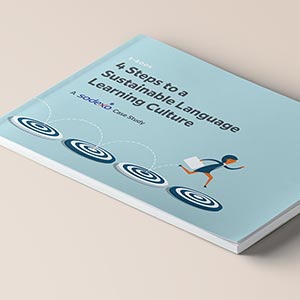While skill gaps in the workplace are a concern for businesses at any time, they are an even more pressing concern in transformational times. From a macro view, the demand for robust technology skills will likely keep increasing, as will the need for teams that are diverse and culturally fluent (which often includes a need for language learning programs). On the micro level, this all leads HR departments and team leads to ask: How can we identify skill gaps in the workplace? And how can we upskill and reskill our workforce?
Though this answer varies from company to company, these questions become more important every day. Fortunately, there are plenty of ways to identify areas for improvement and close the skills gap — and there has never been a better time.
1. Start with strategy.
As the old proverb goes, “When all you have is a hammer, everything looks like a nail.” When it comes to reskilling and upskilling the workforce, it’s worth remembering. In any given business cycle, the world will be abuzz about new technologies and industry-level changes — but not all of them may apply to your company’s goals. To avoid over-correcting or spending resources where you don’t have to, begin the process by looking at the company’s mid- and long-term goals first.
According to LinkedIn’s 2021 Learning Report, 64% of learning and development professionals said that workforce development strategies became a “need to have” priority in 2021. Still, how a company chooses to improve itself must depend on where it wants to go.
2. Survey your employees for qualitative data.
While using Key Performance Indicators (KPIs) is a great tool to determine how well your company is achieving its goals, that data often doesn’t tell the full story. Knowing how many sales someone made or how much customer growth you had is helpful, but when it comes to knowing where the company is struggling internally, KPIs are often still an abstraction.
Because so much of learning is not easily quantified, qualitative data directly from the employees can help when it comes to closing the skills gap. By going beyond the numbers, HR departments and team leads can find where their employees need assistance and allocate the resources needed to make their lives easier.
3. Use 360-degree reviews for a full picture of your business.
To go beyond just an employee survey, 360-degree reviews can be a very helpful tool as well. In determining where a team member’s strengths and weaknesses are, input from the employee themself is needed as well as from their supervisor — but additional feedback from their colleagues and even their customers can provide a comprehensive look at what areas to focus on and what to improve. By comparing input from many sources and identifying common issues, team leads and managers can start closing skill gaps more effectively.
4. Measure your workforce’s existing skills and plan to build on them.
When talking about skill gaps in the workplace, the conversation tends to focus on where a company or team is lacking — but what about areas where your team excels? An important consideration in the post-COVID world is that a company’s talent is not fixed or limited — it’s a renewable resource that can grow and change.
By leaning into your team’s strengths and developing and stretching them into new areas, you may be able to close skill gaps without having to look outside the company. Additionally, reskilling and upskilling your workforce can increase the internal mobility within a company — and according to LinkedIn data, companies with high internal mobility have twice as much employee retention as companies that don’t.
5. Look to the future for bigger work trends.
To effectively close skill gaps in the workplace, it’s important for any company to focus on their own needs and goals first. Still, once those goals are identified, it’s also important to look at the broader business world for trends that could change all industries.
Though it’s clear digitalization and remote work will be around for the long term, research from Gartner also anticipates that employees will push companies into taking stronger political stances on issues of the day, and that states and cities will begin competing to attract individual talent rather than entire companies. Each of these trends will come with its own set of challenges for HR departments and team leads — and skills needed to overcome them.
In many ways, COVID-19 has significantly slowed our pace of life — instead of spending hours each week commuting, many of us conduct business from home, which frees up time for other activities. On the other hand, the pandemic has also sped up the process of digitalization in the business world by several years. In volatile times, some companies run the risk of falling behind — but the ones who face these challenges head-on have an unprecedented opportunity to grow.

Find out how to set up a learning culture in your company in this free ebook and discover how Sodexo closed skill gaps with Babbel.





